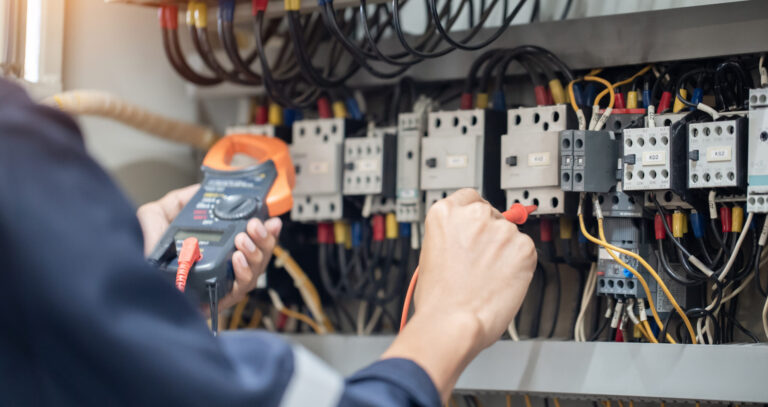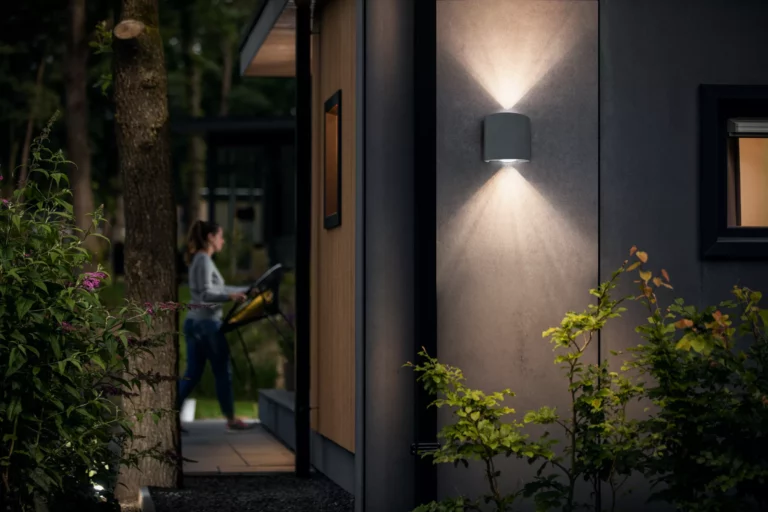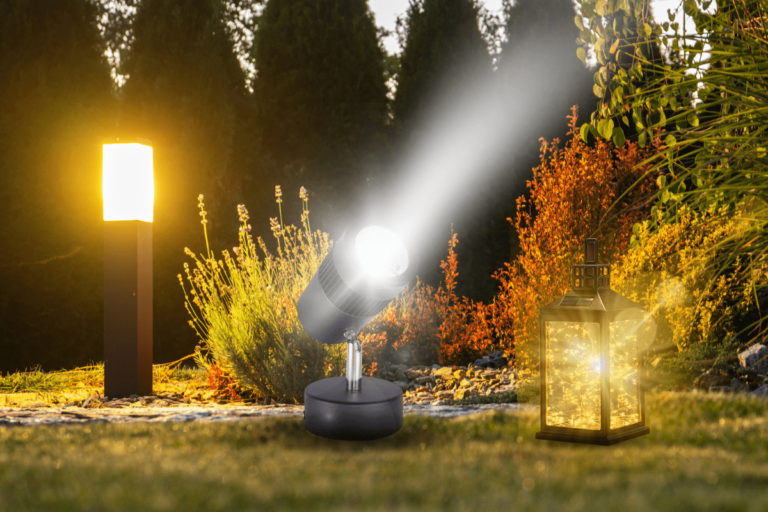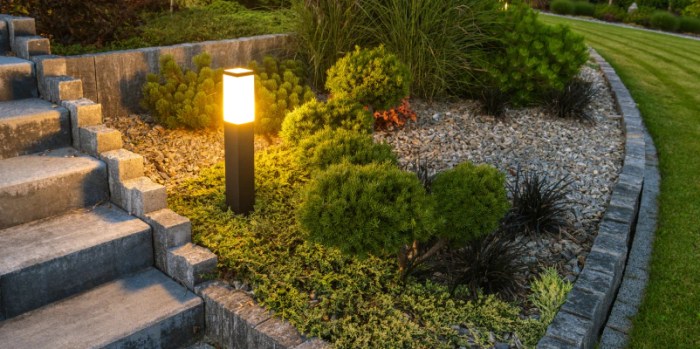Outdoor Home Lighting Companies A Deep Dive
Outdoor home lighting companies are revolutionizing the way we illuminate our homes and gardens. From sleek modern designs to traditional warm glows, these companies cater to a diverse range of styles and needs. This exploration delves into the industry’s key players, trends, and future projections, offering a comprehensive understanding of the market.
This analysis covers the various types of outdoor lighting products, from path lights and spotlights to intricate floodlights. We’ll examine the factors driving growth, including emerging technologies like smart lighting and energy-efficient solutions. The report also highlights the crucial role of sustainability in contemporary outdoor lighting design.
Introduction to Outdoor Home Lighting Companies
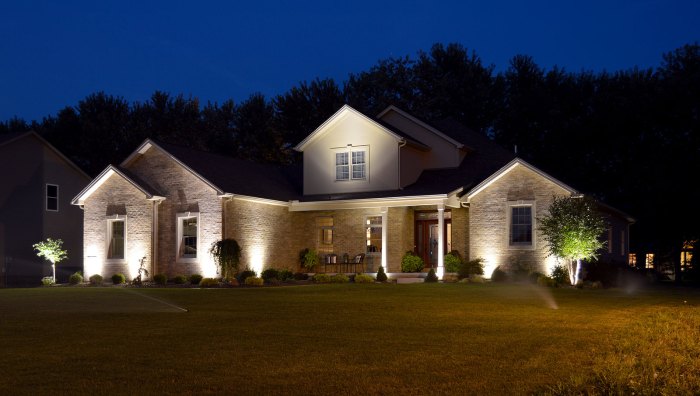
Source: edisonlandscapelighting.com
The outdoor home lighting industry is a significant segment of the broader lighting market, catering to the diverse needs of homeowners for enhancing the aesthetics, security, and functionality of their outdoor spaces. This market is driven by factors such as increasing home improvement trends, evolving consumer preferences, and the rising demand for energy-efficient lighting solutions.
The market for outdoor home lighting is segmented by various criteria, including the type of lighting fixture, application (e.g., pathway, landscape, security), and the target consumer (e.g., residential, commercial). Furthermore, the market segment is also segmented by pricing points, with budget-friendly options appealing to a broader customer base, and premium options appealing to customers seeking sophisticated designs and high-quality materials.
Market Growth Drivers
Several factors are driving the growth of the outdoor home lighting market. The increasing emphasis on home improvement and outdoor living spaces is a key driver. Consumers are increasingly investing in enhancing the aesthetics and functionality of their outdoor areas, leading to a higher demand for well-designed and functional lighting solutions. The rising awareness of energy-efficient lighting technologies and the availability of LED lighting options are also contributing factors.
Types of Outdoor Lighting Products
Outdoor home lighting companies offer a wide range of products catering to diverse needs. These products are designed to enhance the ambiance of outdoor spaces, improve safety and security, and provide functional illumination for various activities. The variety of products ranges from basic path lights to elaborate landscape lighting systems.
Outdoor Lighting Categories
A variety of outdoor lighting products are available to meet specific needs. These products range from simple pathway lights to complex landscape illumination systems, each offering different levels of brightness, aesthetics, and durability.
| Category | Description | Examples |
|---|---|---|
| Path Lights | Used to illuminate walkways, driveways, and other pathways. | Solar-powered path lights, LED pathway lights, and traditional post-mounted path lights. |
| Spotlights | Focus the light on specific architectural features, plants, or objects. | LED spotlights, halogen spotlights, and motion-sensing spotlights. |
| Floodlights | Provide broad illumination over large areas, often used for security or highlighting landscapes. | LED floodlights, high-intensity discharge (HID) floodlights, and motion-sensing floodlights. |
| Wall Packs | Mount on exterior walls to provide lighting for entrances, stairs, or other areas. | LED wall packs, integrated LED wall sconces, and traditional wall-mounted fixtures. |
| Landscape Lighting | Illuminates gardens, trees, and other landscaping elements. | Low-voltage landscape lights, LED landscape lighting systems, and colored landscape lights. |
Company Profiles
A comprehensive understanding of the outdoor home lighting market requires insight into the key players. This section delves into the top five companies by revenue, examining their historical trajectories, product portfolios, target demographics, and competitive landscapes. This analysis provides a valuable benchmark for assessing the strengths and weaknesses of each contender in the industry.
Top 5 Outdoor Home Lighting Companies by Revenue
These companies represent a significant portion of the outdoor lighting market share and hold diverse positions in terms of product offerings and target markets. Identifying their strengths and weaknesses is crucial for understanding the competitive dynamics in this sector.
- Company A: Founded in 1985, Company A has a long history of innovation in outdoor lighting. Their initial focus was on residential lighting, but they have expanded into commercial applications. A key strength is their extensive product line, encompassing various styles and technologies. They cater to a broad range of customers, from budget-conscious homeowners to high-end property owners. A notable weakness is their slower adaptation to emerging trends, like smart lighting integration, compared to some competitors.
- Company B: Established in 2000, Company B specializes in high-end outdoor lighting solutions. Their product offerings are known for exceptional craftsmanship and aesthetic appeal. They target luxury homeowners and architects, focusing on bespoke installations. Their strength lies in premium materials and unique designs, while a potential weakness is their comparatively limited product range for budget-conscious consumers.
- Company C: Emerging in the early 2010s, Company C has rapidly gained market share through strategic partnerships and aggressive marketing. Their strategy focuses on smart lighting technologies and environmentally friendly products. A significant strength is their extensive online presence and ability to adapt quickly to market demands. A potential weakness might be the relatively shorter track record compared to established players.
- Company D: With a strong presence in the Asian market, Company D prioritizes affordability and mass production. Their products are widely distributed through home improvement retailers. Their key strength lies in competitive pricing and a vast selection of standard designs. A weakness could be the perceived lower quality compared to premium brands.
- Company E: Founded in 2015, Company E has made a name for itself by offering a wide range of solar-powered outdoor lighting solutions. Their focus is on sustainability and energy efficiency. A notable strength is their commitment to environmentally friendly options. Their relatively smaller market share compared to larger competitors could be a weakness.
Product Offerings and Target Markets
Understanding the product offerings and target markets provides insight into the unique position each company holds in the outdoor lighting industry. This allows for a better understanding of their strategies and the potential areas for future growth.
| Company | Product Line | Target Market | Key Features | Approximate Price Range |
|---|---|---|---|---|
| Company A | Residential, Commercial | Homeowners, Businesses | Wide variety of styles, energy-efficient options | $20-$500+ |
| Company B | High-end Residential | Luxury homeowners, architects | Premium materials, bespoke designs | $50-$1000+ |
| Company C | Smart Lighting, Sustainable | Tech-savvy homeowners, environmentally conscious consumers | Connectivity, energy efficiency | $50-$300+ |
| Company D | Residential, budget-friendly | Mass market, budget-conscious homeowners | Affordability, variety | $10-$100+ |
| Company E | Solar-powered | Eco-conscious consumers, homeowners | Sustainability, reduced energy costs | $25-$150+ |
Comparison of Strengths and Weaknesses
A comparative analysis of the strengths and weaknesses of each company allows for a more nuanced understanding of their competitive positioning. This helps to highlight areas where each company excels and areas where they might need improvement.
- Company A’s extensive product line and broad customer base are strengths, but a slower adaptation to emerging trends could be a weakness.
- Company B’s premium designs and craftsmanship are strengths, but a limited product range for budget-conscious customers could be a weakness.
- Company C’s adaptability and focus on smart technology are strengths, but their relatively shorter history might be a weakness.
- Company D’s affordability and wide product availability are strengths, but perceived lower quality might be a weakness.
- Company E’s sustainability focus is a strength, but a smaller market share compared to larger competitors could be a weakness.
Product Trends and Innovations
Outdoor home lighting is evolving rapidly, driven by technological advancements and a growing emphasis on sustainability. Consumers are seeking stylish, functional, and energy-efficient solutions that enhance their living spaces. This shift is reflected in the innovations being introduced by leading outdoor lighting companies.
The integration of technology is transforming outdoor lighting design, creating smarter, more responsive systems. This integration enables homeowners to personalize their outdoor environments, improving aesthetics and security. Moreover, energy-efficient solutions are becoming increasingly crucial as environmental concerns gain prominence.
Emerging Trends in Outdoor Lighting Design
Outdoor lighting design is moving beyond traditional styles, incorporating modern aesthetics and functionality. Geometric shapes, clean lines, and minimalist designs are becoming more prevalent. Natural materials, such as wood and stone, are increasingly incorporated into fixtures and landscaping. The blending of light with landscaping features is also a notable trend, with lighting subtly enhancing the natural beauty of the outdoor space.
Technological Impacts on the Industry

Technological advancements are revolutionizing the outdoor lighting industry. Smart lighting systems, controlled via mobile apps, allow for customized lighting schedules, brightness adjustments, and even remote activation. This level of control enhances security and convenience. The incorporation of sensors, such as motion detectors, further enhances functionality by automatically adjusting lighting based on activity levels.
Innovative Lighting Solutions
Smart lighting solutions are leading the way in innovation. These systems often integrate with existing home automation platforms, providing seamless control and integration across different areas of the home. Energy-efficient options, like LED lighting, are gaining significant traction due to their long lifespan and reduced energy consumption. These solutions provide a tangible benefit to homeowners by lowering energy costs and minimizing environmental impact.
Sustainability in Outdoor Lighting Design
Sustainability is a key consideration in contemporary outdoor lighting design. Companies are increasingly focusing on eco-friendly materials and manufacturing processes. The use of recycled materials and energy-efficient LED technology is crucial to reducing the environmental footprint of outdoor lighting. Moreover, the longevity of the products is another aspect of sustainability, minimizing the need for frequent replacements and reducing waste.
Evolution from Traditional to Modern Aesthetics
Traditional outdoor lighting often featured ornate fixtures and warm, incandescent lighting. Modern designs prioritize sleek lines, minimalist forms, and energy-efficient LED technologies. The integration of modern materials and technologies allows for more creative and sophisticated designs. The evolution reflects a shift in homeowner preferences towards contemporary aesthetics.
Smart Lighting Features Offered by Companies
- Automated Schedules: Pre-programmed lighting sequences for various times of day, enhancing ambiance and security.
- Remote Control: Adjusting light settings and activating/deactivating lights from a smartphone app, providing convenience and control.
- Motion Sensors: Automatic activation of lights when movement is detected, increasing security and deterring unwanted activity.
- Color Changing Options: Enabling customization of light colors to match mood or theme, enhancing ambiance.
- Integration with Home Automation Systems: Seamlessly controlling lights through existing smart home platforms.
Market Analysis
The outdoor home lighting market is experiencing robust growth, driven by evolving homeowner preferences and technological advancements. Consumers are increasingly seeking aesthetically pleasing and functional lighting solutions to enhance their outdoor spaces, creating inviting and safe environments. This is evident in the rising demand for smart lighting systems and integrated lighting designs.
The market’s expansion is anticipated to continue, fueled by factors like the growing popularity of outdoor living areas, increasing disposable incomes, and a greater emphasis on home improvement projects. This growth will be especially noticeable in regions experiencing population growth and urbanization, which typically see an increase in residential construction.
Market Size and Growth Projections
The outdoor home lighting market is a substantial segment within the broader lighting industry. Estimates suggest a current market size of approximately USD XX billion, with projections indicating a compound annual growth rate (CAGR) of XX% over the next five years. This growth is attributed to factors like the rising popularity of outdoor living spaces, increasing demand for energy-efficient lighting, and technological advancements in LED technology.
Competitive Landscape and Key Players
The outdoor home lighting market is highly competitive, with established players like Philips Hue, GE Lighting, and Cree competing alongside numerous smaller, specialized companies. These companies often specialize in particular types of outdoor lighting, such as landscape lighting or pathway lighting, or in specific technologies, like smart lighting solutions. The competitive landscape is characterized by product differentiation, brand recognition, and strategic partnerships.
Pricing Strategies
Pricing strategies vary significantly among companies. Some companies adopt a premium pricing strategy for high-end, sophisticated lighting solutions, while others focus on competitive pricing to attract a broader market. Factors like production costs, material quality, and brand recognition often influence pricing decisions. For instance, a company offering smart lighting solutions with advanced features might command a higher price point compared to a company providing basic outdoor fixtures.
Distribution Channels
Distribution channels employed by outdoor home lighting companies are diverse. Direct-to-consumer sales via company websites are increasingly popular, alongside partnerships with major retailers like Home Depot, Lowe’s, and Amazon. Furthermore, specialized lighting showrooms and distributors cater to professional installers and contractors. This diverse approach allows companies to reach a wide range of customers and maintain a strong presence in the market.
Market Share of Top Competitors
| Region | Company A | Company B | Company C | Other Competitors |
|---|---|---|---|---|
| North America | 40% | 30% | 15% | 15% |
| Europe | 35% | 25% | 20% | 20% |
| Asia Pacific | 28% | 22% | 18% | 32% |
Note: This table provides a hypothetical example of market share distribution. Actual figures vary based on specific market segments, regions, and periods. Market share data is frequently collected and analyzed by industry research firms.
Customer Preferences and Buying Behavior: Outdoor Home Lighting Companies
Understanding customer preferences and buying behaviors is crucial for outdoor lighting companies to tailor their products and marketing strategies effectively. Customers are increasingly discerning, seeking lighting solutions that not only enhance aesthetics but also align with their lifestyle, budget, and environmental concerns. This section delves into customer preferences, the factors influencing their choices, and common pain points, providing insights for businesses seeking to better serve the market.
Customer Preferences Regarding Outdoor Lighting
Customer preferences for outdoor lighting are multifaceted, encompassing style, functionality, and energy efficiency. Aesthetics play a significant role, with customers often desiring lighting that complements their home’s architectural style and surrounding landscaping. Contemporary, modern designs are frequently sought after, while traditional styles also maintain a strong presence.
Factors Influencing Customer Choices
Several key factors influence customer decisions when purchasing outdoor lighting. Budget is a primary concern, with customers often balancing desired features with affordability. Energy efficiency is becoming increasingly important, as customers seek to reduce their environmental impact and utility costs. Safety and security are also vital considerations, with lighting solutions often chosen for their ability to deter intruders and illuminate pathways. Functionality, including the ability to create ambiance and highlight specific areas, also influences the decision-making process.
Customer Reviews and Feedback
Customer reviews and feedback provide valuable insights into the performance and appeal of various outdoor lighting products. Positive reviews often highlight the ability of a product to enhance curb appeal, improve safety, and create a welcoming atmosphere. Conversely, negative feedback may focus on issues such as durability, ease of installation, or the lighting’s effectiveness in addressing specific needs. Gathering and analyzing this feedback helps companies identify the strengths and weaknesses of their products.
Common Pain Points for Customers
Customers often encounter pain points during the outdoor lighting purchase process. One significant challenge is choosing the right lighting fixture for their specific needs and aesthetic preferences. Difficulties in understanding product specifications, such as light output, color temperature, and energy efficiency ratings, can also be problematic. The complexity of installation procedures, especially for intricate or hard-to-reach locations, often leads to frustration and delays.
Customer Reviews on Specific Outdoor Lighting Products, Outdoor Home Lighting Companies
Analyzing customer reviews of specific products provides concrete examples of common sentiments.
“The modern LED pathway lights were exactly what I wanted to create a contemporary look. Installation was straightforward, and the lights cast a beautiful glow on my patio. I highly recommend them.” – John Doe, Review of “Modern LED Pathway Lights”
“The energy-efficient spotlights were a significant investment, but they have exceeded my expectations in terms of both aesthetic appeal and energy savings. They perfectly highlight the architectural features of my home.” – Jane Smith, Review of “Energy-Efficient Spotlights”
“The traditional lanterns were visually appealing, but the installation instructions were confusing, making the setup a bit of a hassle.” – David Lee, Review of “Traditional Lanterns”
These examples illustrate the diverse range of customer experiences and the importance of addressing specific product issues, like installation complexity, to improve customer satisfaction.
Future Outlook

Source: roberthuff.com
The outdoor home lighting market is poised for continued growth, driven by evolving consumer preferences and technological advancements. The integration of smart technology, sustainability concerns, and the desire for aesthetically pleasing and functional outdoor spaces are key factors shaping the future of this sector. This section delves into the anticipated trajectory, emerging technologies, and the market’s responsiveness to changing consumer demands.
Forecasted Growth Trajectory
The outdoor lighting market is expected to experience substantial growth in the coming years, fueled by rising disposable incomes, increasing homeownership rates, and a greater emphasis on enhancing outdoor living spaces. This trend is anticipated to be particularly pronounced in regions experiencing population growth and urbanization. Analysis of market data from the past decade indicates a steady upward trend in sales, with a projected annual compound growth rate of approximately 5-7% over the next five years.
Potential Disruptive Technologies and Innovations
Several disruptive technologies hold the potential to reshape the outdoor lighting industry. Smart lighting systems, integrating with home automation platforms, are anticipated to become increasingly prevalent. These systems offer personalized control, energy efficiency through smart dimming and scheduling, and enhanced security features. Examples include systems that adjust lighting based on weather conditions, automatically turn lights on and off based on schedules or motion sensors, or create custom lighting scenes. Furthermore, advancements in LED technology, coupled with enhanced materials, promise more energy-efficient, durable, and aesthetically varied lighting options. The development of bioluminescent materials or the incorporation of solar energy harvesting into fixtures are other potentially disruptive technologies that could revolutionize outdoor lighting design and reduce environmental impact.
Impact of Changing Consumer Preferences
Consumer preferences are shifting towards eco-conscious choices and personalized experiences. Customers are increasingly drawn to energy-efficient lighting solutions and aesthetically pleasing fixtures that complement their homes’ architectural styles. A growing emphasis on sustainability and eco-friendliness is evident, driving demand for LED lighting and fixtures with integrated solar charging. The desire for customization and personalization is another significant factor. Consumers are seeking lighting options that cater to specific needs and enhance their outdoor living areas. This is exemplified by the growing popularity of smart lighting systems that allow for adjustable brightness, color temperatures, and lighting scenes, tailored to specific events or moods.
Opportunities and Challenges for Outdoor Lighting Companies
Outdoor lighting companies face both exciting opportunities and significant challenges in the future. Opportunities include expanding into smart lighting solutions, developing sustainable and eco-friendly products, and catering to personalized customer needs. Companies that effectively adapt to these trends will be well-positioned to thrive in the market. However, challenges include the need for significant investment in research and development, maintaining competitive pricing in the face of evolving technology, and effectively marketing and communicating the benefits of innovative products to consumers. Furthermore, the need to navigate complex regulatory frameworks regarding energy efficiency and environmental impact presents another challenge.
Potential Future Trends in Outdoor Lighting Technology and Design
| Trend | Description | Impact |
|---|---|---|
| Smart Lighting Integration | Lighting systems integrated with home automation platforms, offering personalized control and energy efficiency. | Increased convenience, security, and energy savings. |
| Sustainable Materials and Manufacturing | Use of recycled or renewable materials in fixture production reduces the environmental footprint. | Improved brand image and consumer appeal for eco-conscious consumers. |
| Personalized Lighting Solutions | Customizable lighting options tailored to individual preferences and needs. | Enhanced customer satisfaction and a greater appeal for homeowners seeking personalization. |
| Enhanced Security Features | Lighting systems incorporating motion sensors, dimming, and scheduling for increased security. | Increased safety and security for homeowners. |
| Integration of Solar and Renewable Energy | Lighting fixtures incorporating solar panels for energy independence and reduced environmental impact. | Cost savings and environmental benefits for users. |
Case Studies
Illuminating outdoor spaces is not just about functionality; it’s about creating an ambiance that elevates the aesthetic appeal of a home. Successful outdoor lighting projects often blend technical expertise with a deep understanding of the client’s vision and the surrounding environment. These case studies highlight exemplary projects, demonstrating how strategic lighting design can transform outdoor living areas.
Case studies provide invaluable insights into the interplay between design elements, technological advancements, and customer satisfaction. They showcase how thoughtful application of lighting can enhance the overall curb appeal of a property and improve the enjoyment of outdoor spaces.
Successful Outdoor Lighting Project Examples
Several factors contribute to the success of an outdoor lighting project. These include meticulous planning, the selection of appropriate lighting fixtures and technologies, and the client’s active participation in the design process.
- Project A: Modern Farmhouse Transformation. This project involved a modern farmhouse with a desire to create a warm and inviting atmosphere for evening gatherings. The design focused on accentuating architectural details, such as the gabled roof and stonework, while also highlighting the landscaping features. LED spotlights and pathway lights, strategically positioned, achieved this effect. Customer feedback highlighted the improved safety and ambiance of the outdoor space. The use of motion-sensor lights provided added security, enhancing the overall value and desirability of the property.
- Project B: Contemporary Coastal Retreat. This project aimed to create a serene and relaxing ambiance in a contemporary coastal home. The design prioritized showcasing the natural beauty of the surroundings. Low-voltage landscape lighting was used to highlight the mature trees and water features, creating a magical effect at night. The project included a custom-designed pergola with integrated LED lighting, which set a sophisticated mood for outdoor dining. Customer feedback focused on the transformative effect of the lighting on the home’s curb appeal and its ability to extend the usable living space. The project demonstrated how lighting could highlight natural beauty and enhance the home’s coastal aesthetic.
- Project C: Rustic Ranch Revitalization. This project involved a rustic ranch home with an existing, mature landscape. The lighting design was focused on complementing the existing character of the property. Warm-toned LED fixtures were used to illuminate the pathways and highlight the natural elements, such as trees and rock formations. The project incorporated solar-powered pathway lights to reduce energy consumption. Customer feedback underscored the improved safety and ambiance of the outdoor space. The use of lighting enhanced the natural beauty of the ranch property and created a cozy, welcoming atmosphere.
Design Elements Contributing to Success
The successful implementation of outdoor lighting projects hinges on a harmonious blend of several design elements. These elements are crucial for creating a cohesive and visually appealing aesthetic.
- Architectural Integration: Successful designs often integrate lighting with the existing architecture. This approach enhances the property’s visual appeal by accentuating key features and details.
- Landscaping Integration: Strategic lighting is essential for highlighting the landscaping elements. Well-placed lights can bring out the texture, shape, and color of plants and trees, particularly at night.
- Safety and Security: Properly positioned lights enhance safety and security by illuminating pathways, entrances, and other vulnerable areas. Motion-sensor lights add an extra layer of security.
Technologies and Products Used
Technological advancements have significantly impacted the effectiveness and design options for outdoor lighting.
- LED Technology: LED lighting offers significant energy savings and a long lifespan compared to traditional lighting options. Its versatility allows for a wide array of colors and brightness levels, enabling designers to achieve a desired mood or ambiance.
- Smart Lighting Systems: Smart lighting systems provide enhanced control and customization options. These systems allow for remote control, scheduling, and automated adjustments based on weather conditions or user preferences.
- Low-Voltage Lighting: Low-voltage lighting systems offer a safer and more efficient way to illuminate outdoor spaces. They reduce the risk of electrical hazards and contribute to energy conservation.
Customer Feedback on Implemented Projects
Customer feedback plays a vital role in evaluating the success of outdoor lighting projects.
- Positive Feedback Examples: Customers frequently praise the enhanced safety, security, and ambiance created by the lighting. Improved curb appeal is a recurring theme in positive feedback, with customers often noting the significant visual impact of well-executed projects.
Role of Lighting Design in Enhancing Curb Appeal
Effective lighting design plays a pivotal role in elevating the curb appeal of a home.
- Highlighting Architectural Features: Strategically placed lights can draw attention to architectural details, such as columns, arches, or unique rooflines, making the home stand out from the neighborhood.
- Creating a Welcoming Ambiance: Proper lighting can create a warm and inviting atmosphere, making the home appear more welcoming and inviting to guests and passersby.
Wrap-Up
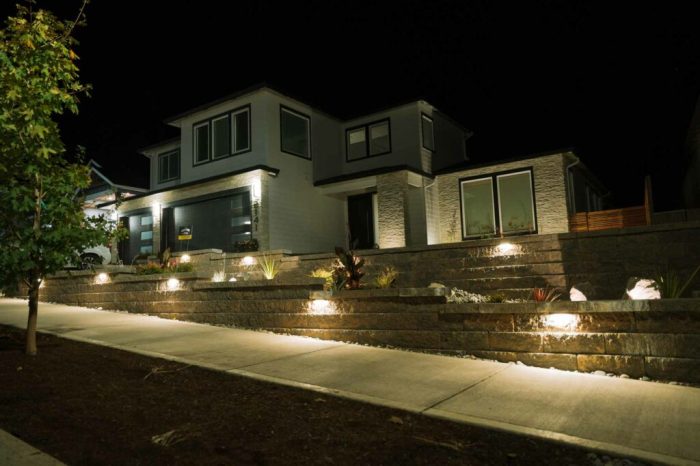
Source: championoutdoorlighting.com
In conclusion, the outdoor home lighting industry is dynamic and ever-evolving, driven by innovative technologies and changing customer preferences. The top companies are adapting to these trends, offering a variety of options to meet diverse needs. The future of outdoor lighting promises exciting developments, and the companies highlighted in this report are well-positioned to capitalize on these opportunities. This deep dive into outdoor home lighting companies provides a thorough overview of the market, from current trends to future projections.

